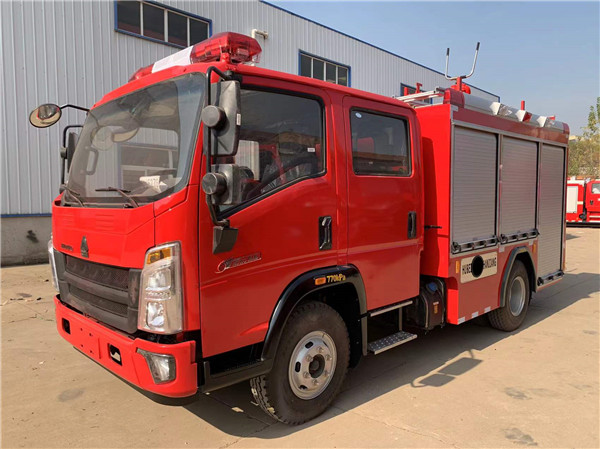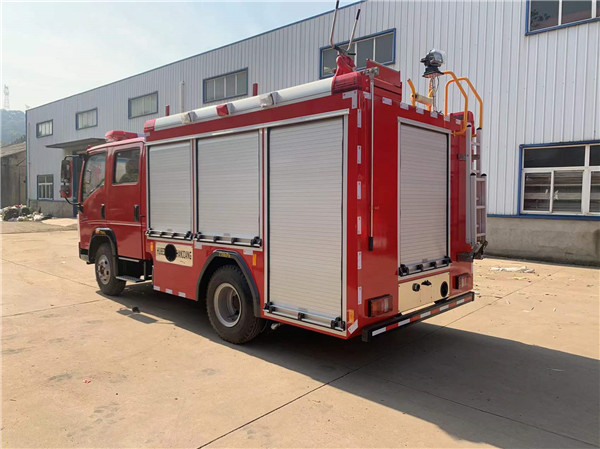Today, we will take you to learn the maintenance methods and precautions of fire trucks.
1. Engine
(1) Front cover
(2) Cooling water
★ Determine the coolant height by observing the liquid level of the coolant tank, at least not lower than the position marked by the red line
★ Always pay attention to the cooling water temperature when the vehicle is driving (observe the water temperature indicator light)
★ If you find that the coolant is lacking, you should add it immediately
(3)Battery
a. Check the battery voltage in the driver display menu. (It is difficult to start the vehicle when it is lower than 24.6V and must be charged)
b. Disassemble the battery for inspection and maintenance.
(4) Air pressure
You can check whether the vehicle air pressure is sufficient through the instrument. (The vehicle cannot be started when it is lower than 6bar and needs to be pumped up)
(5) Oil
There are two ways to check oil: The first is to look at the oil scale on the oil dipstick;
The second is to use the driver’s display menu to check: if you find that you are short of oil, you should add it in time.
(6) Fuel
Pay attention to the fuel position (must be added when the fuel is less than 3/4).
(7) Fan belt
How to check the tension of the fan belt: Press and release the fan belt with your fingers, and the distance to check the tension is generally not more than 10MM.
2. Steering system
Steering system inspection content:
(1). Free travel of steering wheel and connection of various components
(2). The turning situation of the road test vehicle
(3). Vehicle deviation
3. Transmission system
Contents of drive train inspection:
(1). Check whether the drive shaft connection is loose
(2). Check the parts for oil leakage
(3). Test clutch free stroke separation performance
(4). Road test start buffer level
4. Braking system
Brake system inspection content:
(1). Check the amount of brake fluid
(2). Check the “feel” of the brake pedal of the hydraulic brake system
(3). Check the aging condition of the brake hose
(4). Brake pad wear
(5). Whether the road test brakes deviate
(6). Check the handbrake
5. Pump
(1) Degree of vacuum
The main inspection of the vacuum test is the tightness of the pump.
Method:
a. First check whether the water outlets and pipeline switches are tightly closed.
b. Vacuum the power take-off and observe the movement of the pointer of the vacuum gauge.
c. Stop the pump and observe whether the vacuum gauge is leaking.
(2) Water outlet test
The water outlet test team checks the performance of the pump.
Method:
a. Check whether the water outlets and pipelines are closed.
b. Hang the power take-off to open a water outlet and pressurize it, and observe the pressure gauge.
(3) Draining residual water
a. After the pump is used, the residual water must be emptied. In winter, pay special attention to avoid the residual water in the pump from freezing and damaging the pump.
b. After the system comes out of foam, the system must be cleaned and then the remaining water in the system must be drained to avoid corrosion of the foam liquid.
6. Check lubrication
(1) Chassis lubrication
a. The chassis lubrication should be regularly lubricated and maintained, not less than once a year.
b. All parts of the chassis must be lubricated as required.
c. Be careful not to touch the lubricating grease to the brake disc.
(2) Transmission lubrication
Transmission gear oil inspection method:
a. Check the gearbox for oil leakage.
b. Open the transmission gear oil and fill it empty.
c. Use your index finger to check the oil level of the gear oil.
d. If there is a missing wheel, it should be added in time, until the filling port overflows.
(3) Rear axle lubrication
Rear axle lubrication inspection method:
a. Check the bottom of the rear axle for oil leakage.
b. Check the oil level and quality of the rear differential gear.
c. Check the half shaft fastening screws and oil seal for oil leakage
d. Check the front end oil seal of the main reducer for oil leakage.
7. Truck lights
Light inspection method:
(1). Double inspection, that is, one person directs the inspection, and one person operates in the car according to the command.
(2). Light self-checking means that the driver uses the vehicle light self-checking system to detect the light.
(3). The driver can repair the light by checking the condition obtained.
8. Vehicle cleaning
Vehicle cleaning includes cab cleaning, vehicle exterior cleaning, engine cleaning, and chassis cleaning
9. Attention
(1). Before the vehicle goes out for maintenance, the on-board equipment should be removed and the water tank should be emptied according to the actual situation before going out for maintenance.
(2). When overhauling the vehicle, it is strictly forbidden to touch the heat-generating parts of the engine and exhaust pipe to prevent burns.
(3). If the vehicle needs to remove the tires for maintenance, an iron triangle stool should be placed under the chassis near the tires for protection to prevent safety accidents caused by the slipping of the jack.
(4). It is strictly forbidden to start the vehicle when personnel are under the vehicle or doing maintenance at the engine position.
(5). The inspection of any rotating parts, lubrication or refueling system should be carried out with the engine stopped.
(6). When the cab needs to be tilted for vehicle maintenance, the cab must be tilted after removing the on-board equipment stored in the cab, and the support should be locked with a safety rod to prevent the cab from sliding down.
Post time: Jul-19-2022


